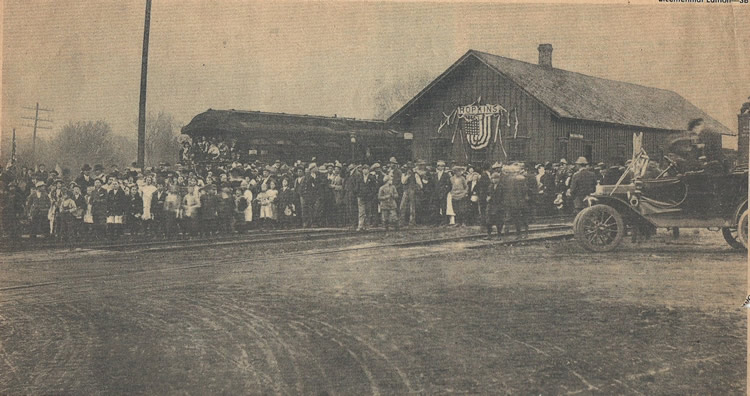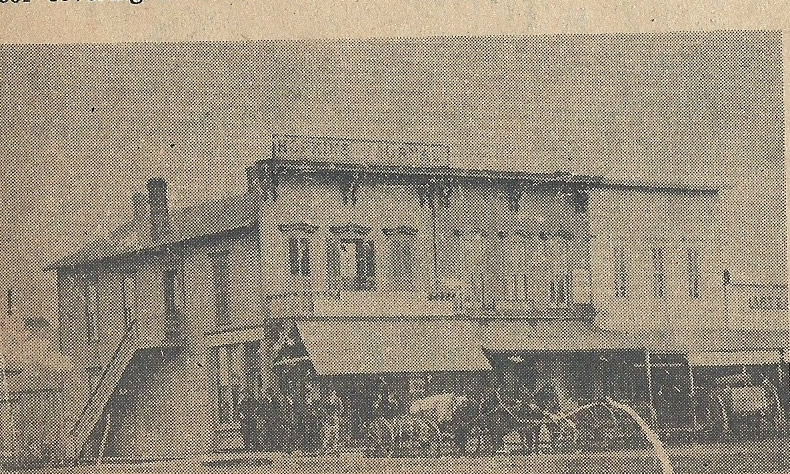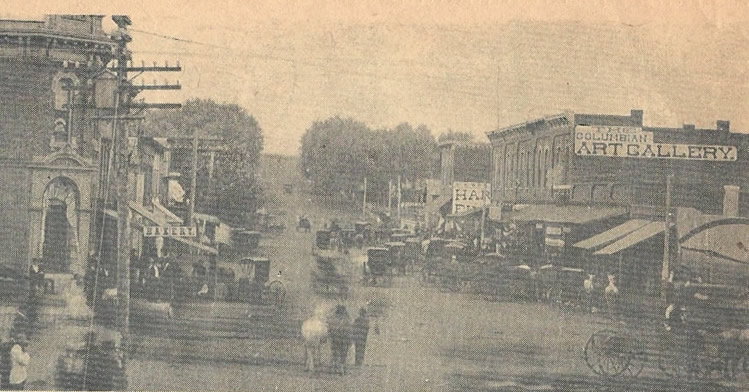The petition defining Hopkins boundaries was taken before the Nodaway County Court on Nov 7, 1871 by Samuel McFarland, pioneer founder of the town.
The town was born in the midst of a small controversy, there being a debate among several persons, including Al Morehouse (later a Missouri Governor) who wanted the town located two miles south of its present location. The town was named after A.L. Hopkins who was at that time superintendent of the Kansas City, St. Joseph & Council Bluffs Railroad Co. The town is located just east of the east fork of the 102 River and was platted in the spring of 1871.
The town was formally incorporated Oct 21, 1872 and the first board of trustees included W.W. Kennison, chairman; Judge E. Donlin, William H. Cochrane, and B.S. Martin.
The town's founder started overland from Texas on Aug 21, 1861 covering a distance of 700 miles to the Old Xenia area despite threats from bushwackers and the Kansas Jayhawkers, McFarland and his wife arrived in the Nodaway County area on Sept 11, 1861 and settled on a farm just north of where Hopkins now stands.
McFarland's obituary from the Dec 27, 1900 issue of "The Hopkins Journal" said in part:
:At the closing of this, the greatest of all centuries, the life of a man who did well his part in helping make the century what it should be, closes with it, and as a result, the usual Christmastime joy and happiness in Hopkins has been intermingled with sadness.
"Uncle Sammy McFarland was at all times enterprising and loyal to Hopkins, never failing to work for and to contribute liberally to any movement calculated to be of benefit to the town and its citizens and in his death we all lose a friend whose friendship meant something."
The first settler into the general Hopkins area was John Kimball who moved into land north of the present township in 1845. Washington Downing the next settler, moved into an area two miles southeast of the town and the Cox settlement, three miles west of Hopkins, was begun about 1850.
 |
The first rail car, the sign of boom for most towns in that era, arrived on Dec 12, 1870 and its arrival heralded a parade of other first:
--The first building was a boarding house built for Thomas Galdman by A. Watson which was located directly west of the tracks.
--Donlin and Brown was one of the pioneer business firms with other firms beginning at about the same time including Porter, Girad & Hughes, druggists; Goodsill Brothers, lumberyard; Finch & Stone, agricultural house; Linville, hardware and DeHaven Restaurant.
--Construction of the first hotel, The Hopkins House, was begun by M.J. Couch but he sold out to David Bender before it was completed. The hotel was located directly west of the depot. William R. Johnston built the Johnston House (also known as Freemont House and St James Hotel) on Roseberry St.
--Edward C. Wolfers erected the first brick building in 1877 (now Young's grocery) and went into trade in dry goods and groceries. Bricks for these buildings were made in Hopkins at a kiln located on the present O.L. Mutti farm at the southwest edge of town.
--Rev Lewis Morton, a Methoidst, said he preached the first sermon, married the first couple and traded the first horses in Hopkins. He was in the [paper missing].
--The first school building was on the northwest edge of Hopkins, reportedly about two blocks west of the J.L. Houston Co. Manufacturing plant. Miss Emma Rose was the first teacher.
--Wolfers Mercantile Co. had the first telephone, a private line to their associate store at Pickering.
--Dr S.D. Large had the first automobile, an Oldsmobile.
--One of the first telegraph operators was William Jerome. His cousin, Jenny Jerome, married Lord Randolph Churchill and she became the mother of Winston Churchill, one of World War II's great statesmen and heroes.
--The first picture show was operated by Charles Fleming and Grant Wilson in a tent located on the site of the present "Hopkins Journal" office.
 |
--Religious activites were intergral in the lives of Hopkins' early settlers. Meetings were held in schoolhouses and log cabins by circuit riders and missionaries who traveled from place to place.
Methodism is generally dated in Hopkins from 1860. The first quarterly conference was held in Hopkins on May 20, 1871 and at that meeting the church extension committee reported that the Hopkins Town Company had donated lot number 8 in block 42 for the building of a church. The only stipulation was that "a decent building be erected on said lot within a reasonable time." The building was erected in 1871 at a cost of $2,000. The present Methodist congregation meets in the Wray Memorial United Methodist Church which was first dedicated in December 1901 with a new educational annex being constructed on the east side of the building in 1971.
The Hopkins Baptist Church was organized in May 1877 and in 1879 joined the Northwest Baptist Association and later that year purchased a 24x33 foot frame building for $400 for use as a church. This is the lot of the church's present location. Extensive additions were made to the church in 1920, 1956, 1966 and 1968 gradually transforming the single room building into a 40x50 foot structure equipped with a kitchen, dining space and several Sunday School classrooms in the full basement.
The First Christian Church of Hopkins was organized March 19, 1882 with N. Rolla Davis as the evangelist. The first meetings of the congregation were held in the Odd Fellows Hall above the Wolfers Store. The first building was dedicated June 21, 1885 and served until it was torn down in 1908. That building was dedicated April 25, 1909 with an extensive remodeling job, costing $40,000 being done in 1961.
The Unity Church of Christ was first housed in a building in 1910. That structure was razed by the Hopkins tornado in 1952 and meetings were held in the Unity school until a new building could be completed and dedicated on July 1, 1954.
The church was first organized with about 40 members.
The First Presbyterian Church was the second church to be built in the Hopkins Community. The congregation, which had been meeting with the Methodist, was formally incorporated in June 1873. In the spring of 1875 funds were raised for a 28x50 foot building but the work was delayed because "of the financial stringency in the entire country, the work was delayed for sometime. This was the year of the great grasshopper plague in Iowa and Missouri." The building was completed in 1876 at a cost of $2,400. This building was razed and replaced with a second structure which burned to the ground in a fire caused by exploding acetylene lights and the third church was erected in 1906 at the intersection of Fourth and Barnard streets. In the 1920s the church became inactive and the trustees in 1925 sold the building to Xenia Lodge No 50 A.F. & A.M. and it is now known as the Masonic Temple.
The Hopkins Independent School District was organized in October 1875 and continued under that name until 1959 when county-wide reorganization took place.
The first graduation exercises were held in the Methodist Church on March 28, 1890.
In 1892 the school district tore down its old wooden building and erected a six room brick structure at a cost of $11,000. When first built it was one of the finest school buildings in the area and has been twice remodeled is still in use today.
In 1916 the school was accredited by the state, had a faulty of nine and 257 students. In fall 1938 the Hopkins district sent out the first school bus too into the rural areas to bring in high school students and the service proved so popular that the board had to purchase a second bus. In 1945 the school started its hot lunch program--meals cost a dime and two vocational programs were also added to the curriculum.
In 1955 five rural schools annexed to the Hopkins District--Unity, Maple Grove, Lone Star, Mt Vernon and Gaynor--and on March 10, 1959 a county-wide reorganization was approved by the voters and 21 smaller districts united to form the North Nodaway R-VI District. School opened on Aug 31, 1959 with 490 students enrolled with a faculty of 27 and the high school offering 39 1/2 units of study. In 1966 a kindergarten was added and even later a vocation-business department was also started. The school currently has 19 classrooms in Hopkins and seven more in Pickering.
Civic improvements are a long tradition in Hopkins and here is a brief chronology:
WATER. Private wells were the first source of water until 1913 when the city approved a $12,000 city waterworks system which was complete on April 9, 1914.
GAS. Gas lights were first turned on in the city in 1904 and were used until 1915.
ELECTRIC LIGHTS. On June 2, 1914 the city approved an electric light system proposal by Harry A. Dalby. The lights were first turned on Nov 12, 1914 for 18 hours a day. Frank Mahan was the first Hopkins citizen to have his home wired for electricity. The plant was destroyed by fire on March 28, 1923 and Jack Dragoo who owned the plant rights at the time sold them to Maryville Light & Power Co which extended its services to the town.
TELEPHONES. The first phones system started operation on Jan 20, 1899 and the first subscription list numbered 24 businesses and 18 private homes. The Mutual Telephone Company was given a city franchise in 1908 and that system was sold to the United Telephone Company in 1953. The changeover to the dial system was made in 1961.
SEWERS. The voters of Hopkins approved an $180,000 bond issue for a sewerage system in 1965 to serve the city and it was completed in September 1967.
 |
Disasters have also played a part in Hopkins' history.
There have been several tornadoes in the area, the first recorded in 1881, on a June Sunday was the severest recorded in that area at the time, destroying or damaging several farms and killing one person and injuring eight others. On Easter Sunday 1909 another tornado swept through Hopkins causing between $20,000 to $25,000 worth of damage.
The most devastating tornado, however, struck about 4:45 pm Sunday Nov 16, 1952. The tornado "brought havoc" to 50 of the 60 businesses and damaged or destroyed 231 homes. A conservative damage estimate was $1,250,000 and the governor declared the city a disaster area three days later and President Harry S Truman made $19,600 available to aid in the clean-up operation.
There were also two years when grasshoppers scourged the crops in the area -- 1866 and 1875 -- in the latter year over two-thirds of the entire area crop was destroyed within a matter of hours.
The Hopkins Picnic is another bit of history worthy of interest -- it was begun in the 1880s and has continued undiminished since then with the only suspensions of the celebration being during World Wars I and II. It has gradually evolved into a celebration with floats, queens, and entertainment which pleased almost everyone.
Active organizations in Hopkins now include the Glen Ulmer Post No 107 of the American Legion, the Hopkins Lions Club, Hopkins Chapter No 401 of the Order of the Eastern Star, Xenia Lodge No 50 A.F. & A.M., North Nodaway 4-H Club, Fourleaf Clover 4-H Club, Troop 65 of the Boy Scouts, Chapter K, PEO and many other social and civic Clubs.